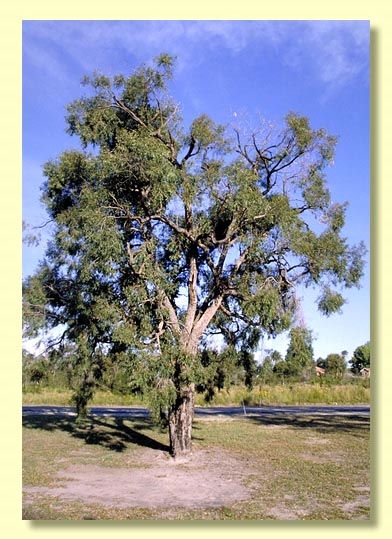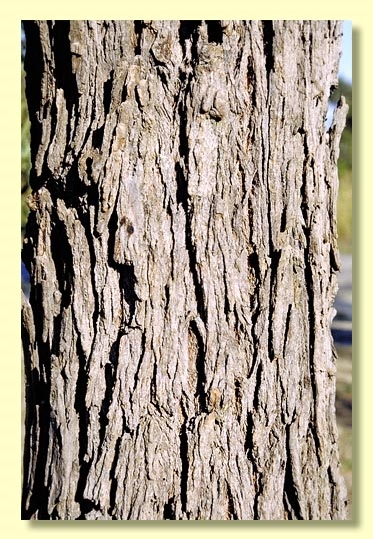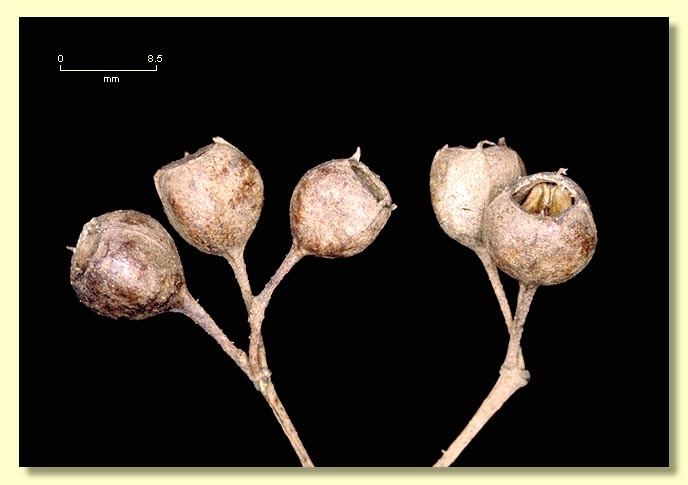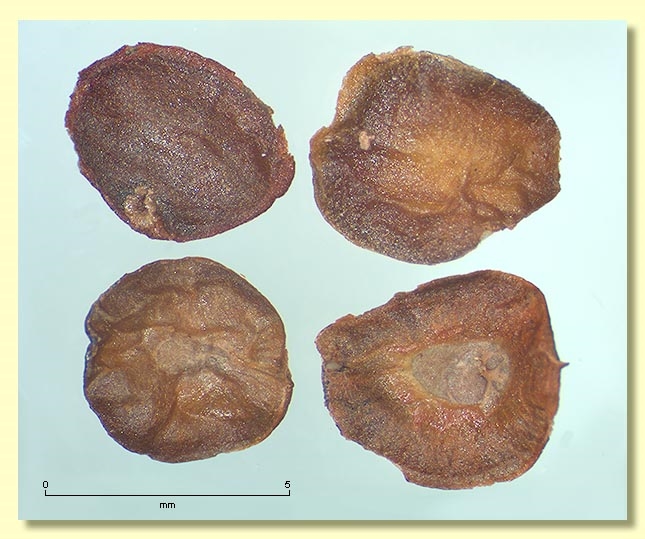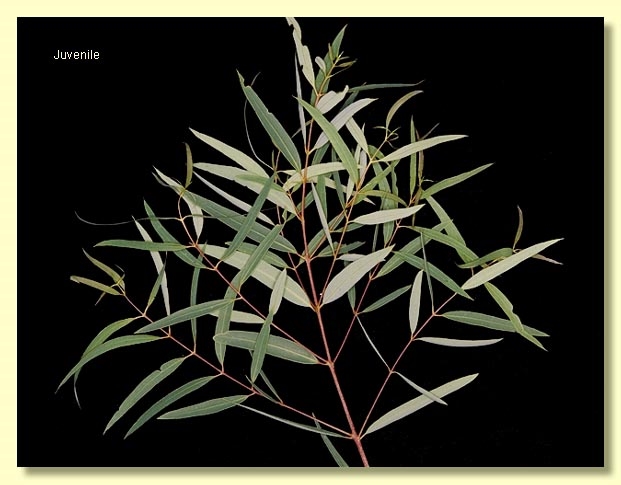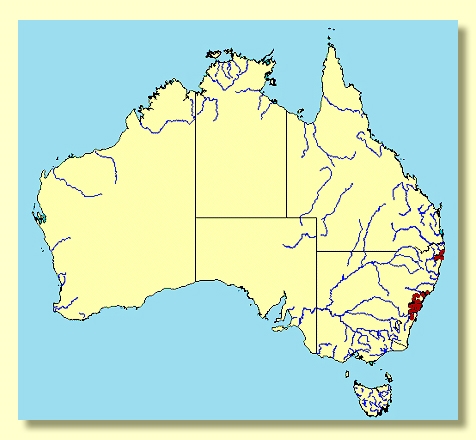Angophora
Euclid - Online edition
Angophora bakeri subsp. bakeri
Angophora bakeri E.C.Hall, J. & Proc. Roy. Soc. New
South Wales 47: 103, t. iv (1913) subsp. bakeri.
T: around Sydney,
NSW; plate iv in E.C.Hall, loc. cit; lecto, fide G.J.Leach,
Telopea 2: 762 (1986); A. lanceolata var. angustifolia
A.Gray, U.S. Expl. Exped., Phan. 1: 556 (1854). T: New South Wales, 'Newington';
collector unknown; holo: GH (photo!), fide G.J.Leach,
Telopea 2: 762 (1986).
A. bakeri subsp. paludosa
G.J.Leach, Telopea 2: 764 (1986); A. paludosa (G. Leach) K.R.
Thiele & P.Y. Ladiges, Cladistics: 41 (1988). T: New South Wales; 10
km south of Woodburn on Pacific Highway, G.J.Leach 195; holo: LTB; iso:
NSW.
A. exul K.D.Hill, Telopea 7 (2) 100 (1997). T: New
South Wales: North Western Slopes: Gibraltar Rock, W of Tenterfield,
K.D.Hill 4788, L.C.Stanberg & K.L.Wilson, 22 Feb 1996; holo: NSW;
iso: AD, BRI, CANB, K, MEL, MO, NY, P.
Small to medium-sized tree to 20 m tall. Forming a lignotuber.
Bark rough to the small branches, soft fibrous corky, sometimes longitudinally fissured, grey to grey-brown. Glands (or ducts) sometimes present in the pith but only seen just below the nodes on young branchlets.
Juvenile growth (coppice or field seedlings to 50 cm): stem rounded in cross-section; juvenile leaves opposite, sessile to shortly pedicellate, narrowly lanceolate to linear, 5–10 cm long, 0.4-1 cm wide, base tapering to the petiole (sometimes auriculate), margin entire, apex acute, green, glabrous.
Adult leaves opposite, petioles 0.3–1 cm long; blade narrowly lanceolate to linear, sometimes falcate, 5–13 cm long, 0.5-1.5 cm wide, flat, base tapering to petiole, margin entire, discolorous, glossy green, penniveined, dense to very densely reticulate, intramarginal vein present, oil glands small island.
Inflorescence terminal, peduncles 0.4–2 cm long, buds 3 or 7 per umbel, pedicellate (pedicels 0.5–1.2 cm long). Mature buds globular (0.4–0.5 cm long, 0.4–0.5 cm wide), hypanthium usually pubescent (sometimes glabrous), longitudinally ribbed, petals white with green keel; stamens inflexed, anthers oblong, versatile, dehiscing by longitudinal slits (non-confluent), style long, stigma blunt, or mop-like, locules 3 or 4, the placentae each with 5 vertical ovule rows. Flowers white or creamy white.
Fruit pedicellate (pedicels to 0.6–1 cm long), cup-shaped to barrel-shaped, 0.7–1 cm long, 0.7–1.2 cm wide, longitudinally ribbed, disc descending, valves 3 or 4, enclosed.
Seeds reddish brown to brown, 4.5–6 mm, flattened-ellipsoidal, dorsal surface smooth, hilum ventral.
Cultivated seedlings (measured at ca node 10): cotyledons reniform to orbicular; stems rounded in cross-section, scabrid with bristle-glands and hairs; leaves opposite, sessile, linear to lanceolate, 5.5–11 cm long, (0.7)1–2(2.5) cm wide, amplexicaul, margin entire, apex pointed, discolorous, green, usually sparsely scabrid.
Flowering has been recorded in December, January and February.
A. bakeri is normally a small tree with narrow adult and juvenile leaves usually less than 1.5 cm wide. It is related to the group of Angophora species that have rough bark and develop true petiolate adult leaves in the mature crown. The other members of this group are A. floribunda, A. woodsiana, A. inopina and A. melanoxylon. A. floribunda and A. woodsiana are usually taller trees with longer petioles and broader adult and juvenile leaves (normally greater than 1.5 cm wide). A. inopina, a small tree similar in habit to A. bakeri, differs also by having broader adult and juvenile leaves. A. melanoxylon, of inland northern New South Wales and southern Queensland, normally has a mixture of petiolate adult leaves and sessile juvenile leaves in the mature crown. The true adult leaves tend to be slightly shorter and broader than those in A. bakeri.
There are two subspecies:
A. bakeri subsp. bakeri
This form is widespread and notably narrow-leaved. The leaves are thin and flexible.
A. bakeri subsp. crassifolia (Latin crassus, thick, and folium, leaf).
This is restricted in distribution, occurring in the Sydney region on sandstone, e.g. Ku-ring-gai Chase. It differs by the rigid, thicker leaves.
MORE ABOUT ANGOPHORA
In 1901 Richard Baker succeeded J.H. Maiden as curator and economic botanist at the Sydney Technological Museum and remained in this position until his retirement in 1921. He was a prolific writer who published many papers, three of which are A Research on the Eucalypts, especicially in regard to their essential oils (1902), A Research on the Pines of Australia (1910), The Hardwoods of Australia and their Economics (1919). He made a significant contribution to the knowledge of the native timber species of eastern Australia. In 1921 he was awarded the Mueller medal by the Australasian Association for the Advancement of Science and in 1922 was awarded the Clarke Medal of the Royal Society of New South Wales.
subsp. crassifolia: Latin crassus, thick and folium, leaf.

